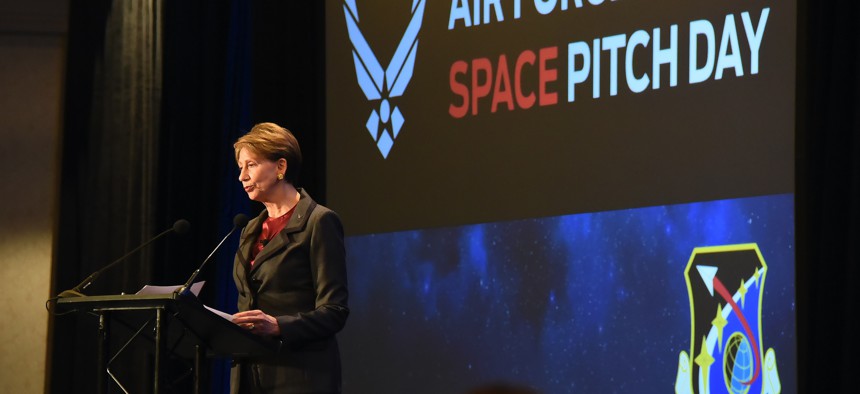
Secretary of the Air Force Barbara Barrett speaks during the commencement of the U.S. Air Force Space Pitch Day, Nov. 5, 2019, San Francisco, Calif. U.S. Air Force / Senior Airman Christian Conrad
Three Tweaks to Foster Innovative Defense Products
Even the Pentagon can’t lavish billionaire-level cash on every promising tech startup — but it can make several moves that help.
Pentagon brass fretting about their dwindling technological advantage should take a look at Palantir and Anduril — two innovative companies that are applying commercial tech to military problems — and ponder: how can we help non-billionaire-backed companies do the same? Although the Defense Department cannot give promising young startups millions of dollars, as Peter Thiel and Palmer Luckey did, it can make three tweaks to help the U.S. realize an American brand of “military-civil fusion.”
First, part of Palantir and Anduril’s success comes from designing solutions independent of requirements. This suggests that the Defense Department should let companies solve problems instead of respond to overly detailed requests for proposals. Innovative companies working on technology solutions that do not perfectly align with an RFP are more likely to respond to a broad solicitation. The Defense Innovation Unit has a useful model for flexible solicitations that should be more widely adopted. As well, the Defense Department should continue to expand its use of Other Transaction authorities, especially production OTs. These measures would make it easier for companies to apply their technology to defense problems instead of altering their product to match stringent government requirements.
Second, Thiel and Luckey funded Palantir and Anduril before attracting VC funding and winning defense contracts. This made it possible for them to develop and test useful products. The government can provide companies with a longer runway to develop their products to meet defense needs by fine-tuning several existing programs. One example is a tweak to the dozens of service-run pitch days (e.g., Air Force and Army) and Small Business Innovation Research, or SBIR, and Small Business Technology Transfer, or STTR, (e.g., Air Force, Army, and Navy) award programs. These are already useful initiatives whose awards demonstrate government interest in a product or idea and provides modest checks that can be used to develop products and build out teams. But even better is the new the AFWERX Open Topic effort that strongly encourages companies to gain letters of support from defense organizations indicating that those organizations are hungry for the technology solution. Absent a customer, there is no VC investment. Therefore, the government should act like a Thiel or Luckey by using pitch day and SBIR/STTR awards to provide companies with funding to develop their product, but to also connect them with defense organizations that need and want to deploy the technology.
Links to defense customers would help companies develop their products to meet Pentagon needs and prove their business model, which would in turn help them attract venture capital. Although the amounts of funding in the government awards will pale in comparison to the amounts of funding Palantir and Anduril had to get started, it would enable companies to overcome the problem companies face in needing capital to develop a product but not being able to attract capital until they have capital. It would also allow companies to demonstrate product-mission fit. The Office of Naval Research’s Naval Accelerator program under Rich Carlin and Maria Medeiros is a good example of how this might be done.
Related: China Is Closing the Innovation Gap: Report
Related: So Many Innovation Centers. So Hard to Find the One You Need
Related: All This ‘Innovation’ Won’t Save the Pentagon
Third, per Trae Stephens’ “spray and pray” diagnosis, the Pentagon must begin to make larger awards to fewer companies. Writing fewer checks of larger amounts with fewer milestones baked into the award will provide the funding that defense companies need to develop and deploy their products. Moreover, developing a pathway from pilot programs to long-term production contracts at fixed prices would help companies navigate the process and signal to investors which companies the government views as being most valuable. Connecting pitch day winners and SBIR/STTR awardees with the Department’s recent changes to OTs would increase a company’s chances of gaining a production contract which, in-turn, would attract investors. The outcome would be enabling cash-strapped companies to flourish in the same way as Palantir and Anduril.



